lock KIA FORTE 2017 Owners Manual
[x] Cancel search | Manufacturer: KIA, Model Year: 2017, Model line: FORTE, Model: KIA FORTE 2017Pages: 595, PDF Size: 11.5 MB
Page 5 of 595
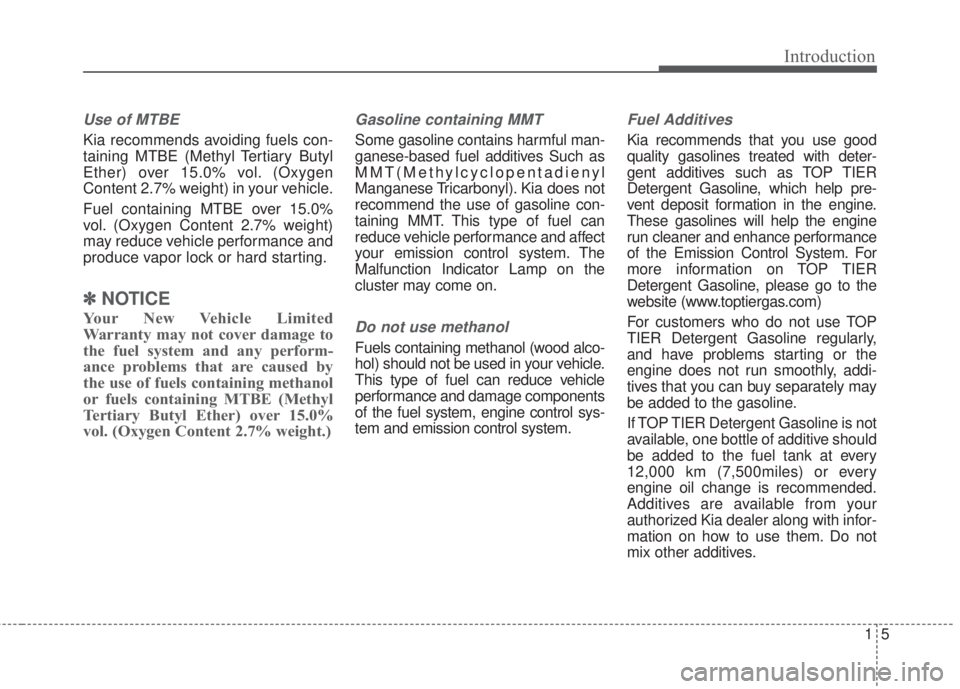
15
Introduction
Use of MTBE
Kia recommends avoiding fuels con-
taining MTBE (Methyl Tertiary Butyl
Ether) over 15.0% vol. (Oxygen
Content 2.7% weight) in your vehicle.
Fuel containing MTBE over 15.0%
vol. (Oxygen Content 2.7% weight)
may reduce vehicle performance and
produce vapor lock or hard starting.
✽ NOTICE
Your New Vehicle Limited
Warranty may not cover damage to
the fuel system and any perform-
ance problems that are caused by
the use of fuels containing methanol
or fuels containing MTBE (Methyl
Tertiary Butyl Ether) over 15.0%
vol. (Oxygen Content 2.7% weight.)
Gasoline containing MMT
Some gasoline contains harmful man-
ganese-based fuel additives Such as
MMT(Methylcyclopentadienyl
Manganese Tricarbonyl). Kia does not
recommend the use of gasoline con-
taining MMT. This type of fuel can
reduce vehicle performance and affect
your emission control system. The
Malfunction Indicator Lamp on the
cluster may come on.
Do not use methanol
Fuels containing methanol (wood alco-
hol) should not be used in your vehicle.
This type of fuel can reduce vehicle
performance and damage components
of the fuel system, engine control sys-
tem and emission control system.
Fuel Additives
Kia recommends that you use good
quality gasolines treated with deter-
gent additives such as TOP TIER
Detergent Gasoline, which help pre-
vent deposit formation in the engine.
These gasolines will help the engine
run cleaner and enhance performance
of the Emission Control System. For
more information on TOP TIER
Detergent Gasoline, please go to the
website (www.toptiergas.com)
For customers who do not use TOP
TIER Detergent Gasoline regularly,
and have problems starting or the
engine does not run smoothly, addi-
tives that you can buy separately may
be added to the gasoline.
If TOP TIER Detergent Gasoline is not
available, one bottle of additive should
be added to the fuel tank at every
12,000 km (7,500miles) or every
engine oil change is recommended.
Additives are available from your
authorized Kia dealer along with infor-
mation on how to use them. Do not
mix other additives.
Page 10 of 595
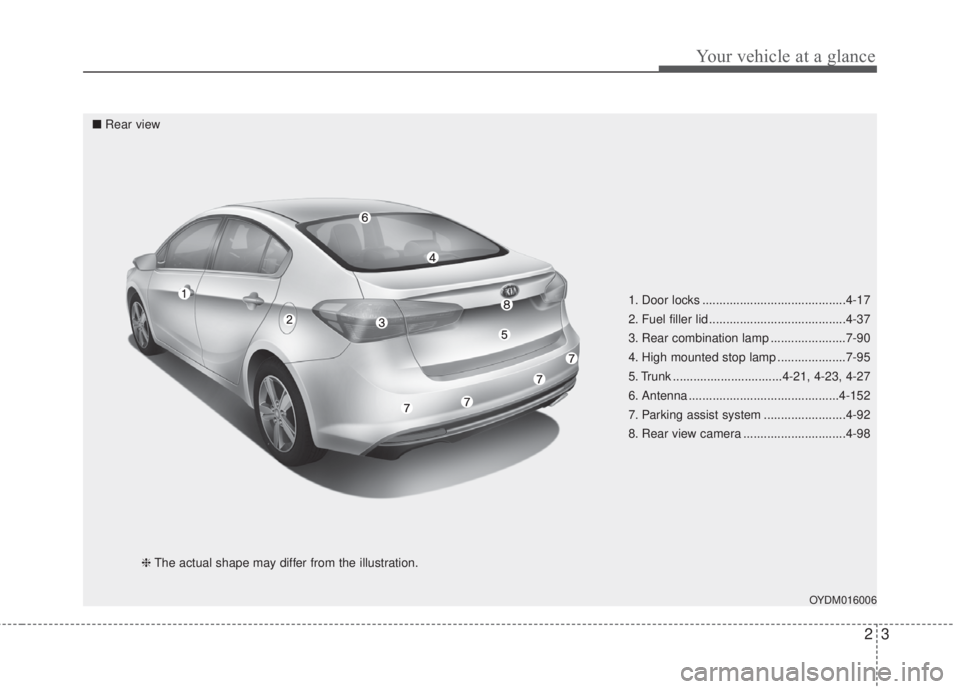
23
Your vehicle at a glance
1. Door locks ..........................................4-17
2. Fuel filler lid ........................................4-37
3. Rear combination lamp ......................7-90
4. High mounted stop lamp ....................7-95
5. Trunk ................................4-21, 4-23, 4-27
6. Antenna ............................................4-152
7. Parking assist system ........................4-92
8. Rear view camera ..............................4-98
OYDM016006
■Rear view
❈The actual shape may differ from the illustration.
Page 11 of 595
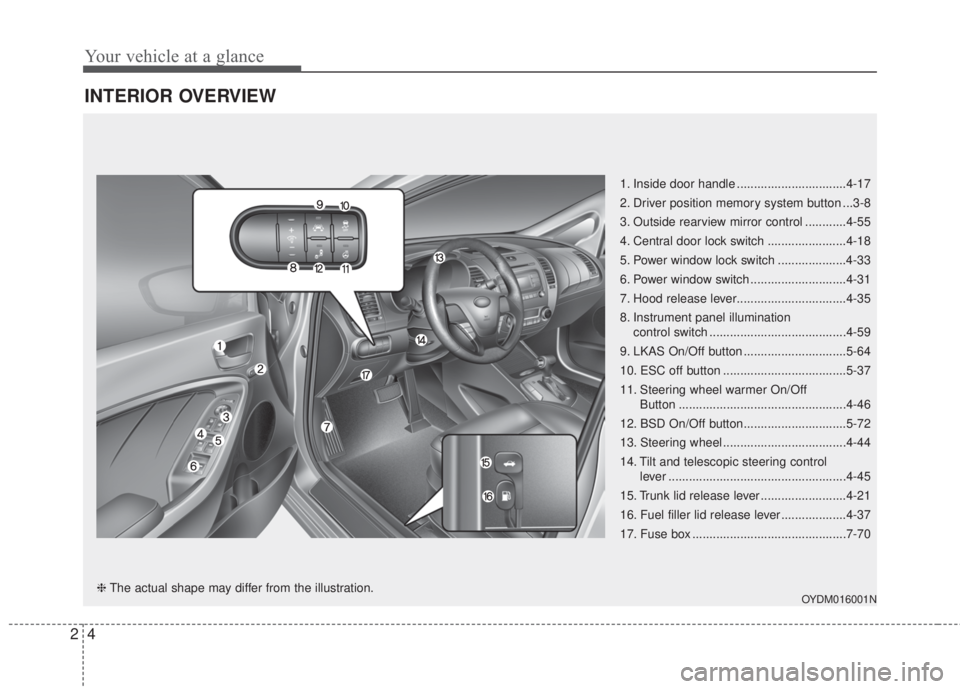
Your vehicle at a glance
4 2
INTERIOR OVERVIEW
1. Inside door handle ................................4-17
2. Driver position memory system button ...3-8
3. Outside rearview mirror control ............4-55
4. Central door lock switch .......................4-18
5. Power window lock switch ....................4-33
6. Power window switch ............................4-31
7. Hood release lever................................4-35
8. Instrument panel illumination
control switch ........................................4-59
9. LKAS On/Off button ..............................5-64
10. ESC off button ....................................5-37
11. Steering wheel warmer On/Off
Button .................................................4-46
12. BSD On/Off button..............................5-72
13. Steering wheel ....................................4-44
14. Tilt and telescopic steering control
lever ....................................................4-45
15. Trunk lid release lever .........................4-21
16. Fuel filler lid release lever ...................4-37
17. Fuse box .............................................7-70
OYDM016001N❈The actual shape may differ from the illustration.
Page 12 of 595
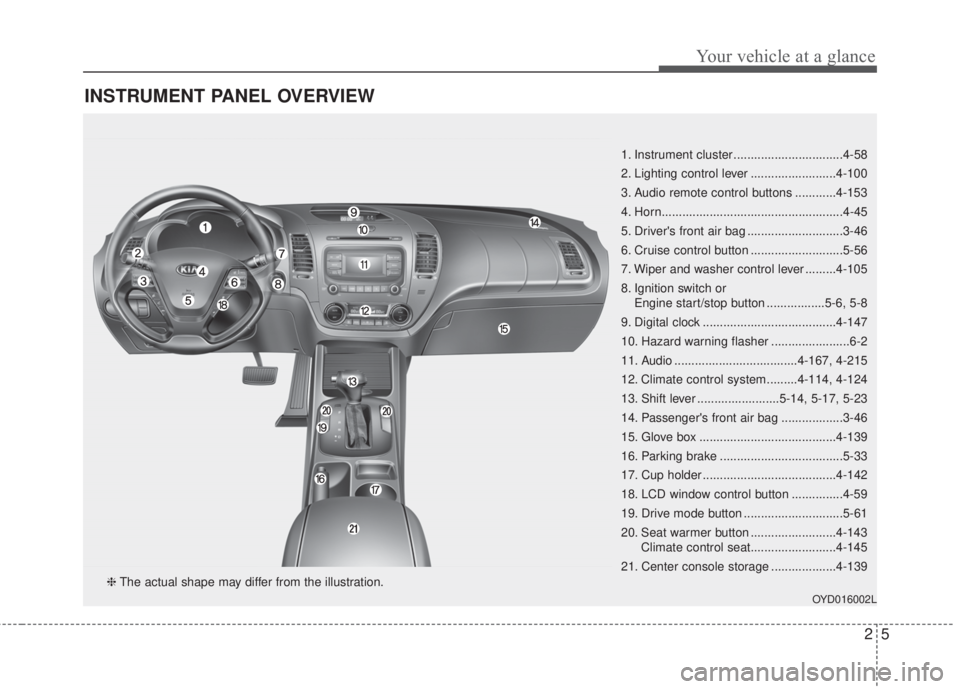
25
Your vehicle at a glance
INSTRUMENT PANEL OVERVIEW
1. Instrument cluster ................................4-58
2. Lighting control lever .........................4-100
3. Audio remote control buttons ............4-153
4. Horn.....................................................4-45
5. Driver's front air bag ............................3-46
6. Cruise control button ...........................5-56
7. Wiper and washer control lever .........4-105
8. Ignition switch or
Engine start/stop button .................5-6, 5-8
9. Digital clock .......................................4-147
10. Hazard warning flasher .......................6-2
11. Audio ....................................4-167, 4-215
12. Climate control system.........4-114, 4-124
13. Shift lever ........................5-14, 5-17, 5-23
14. Passenger's front air bag ..................3-46
15. Glove box ........................................4-139
16. Parking brake ....................................5-33
17. Cup holder .......................................4-142
18. LCD window control button ...............4-59
19. Drive mode button .............................5-61
20. Seat warmer button .........................4-143
Climate control seat.........................4-145
21. Center console storage ...................4-139
OYD016002L
❈The actual shape may differ from the illustration.
Page 18 of 595

Safety features of your vehicle
4 3
Front seat adjustment - manual
Forward and backward
To move the seat forward or backward:
1. Pull the seat slide adjustment
lever up and hold it.
2. Slide the seat to the position you
desire.
3. Release the lever and make sure
the seat is locked in place.
Adjust the seat before driving, and
make sure the seat is locked securely
by trying to move forward and back-
ward without using the lever. If the
seat moves, it is not locked properly.
WARNING- Unexpected
seat movement
After adjusting a manual seat,
always check that it is locked by
shifting your weight to the front
and back. Sudden or unexpect-
ed movement of the driver's
seat could cause you to lose
control of the vehicle.
OYDDSA2002
WARNING- Seat
adjustment
• Do not adjust the seat while
wearing seat belts. Moving the
seat forward will cause strong
pressure on the abdomen.
• Do not place your hand near
the seat bottom or seat track
while adjusting the seat. Your
hand could get caught in the
seat mechanism.
WARNING- Small Objects
Use extreme caution when pick-
ing small objects trapped under
the seats or between the seat
and the center console. Your
hands might be cut or injured
by the sharp edges of the seats
mechanism.
Page 19 of 595
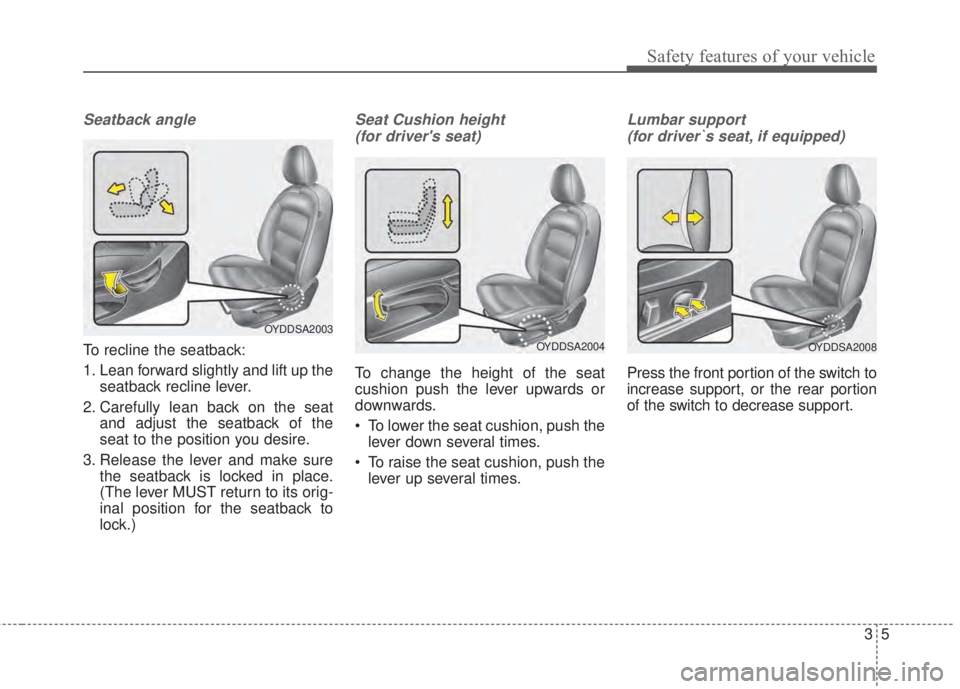
35
Safety features of your vehicle
Seatback angle
To recline the seatback:
1. Lean forward slightly and lift up the
seatback recline lever.
2. Carefully lean back on the seat
and adjust the seatback of the
seat to the position you desire.
3. Release the lever and make sure
the seatback is locked in place.
(The lever MUST return to its orig-
inal position for the seatback to
lock.)
Seat Cushion height
(for driver's seat)
To change the height of the seat
cushion push the lever upwards or
downwards.
• To lower the seat cushion, push the
lever down several times.
• To raise the seat cushion, push the
lever up several times.
Lumbar support
(for driver`s seat, if equipped)
Press the front portion of the switch to
increase support, or the rear portion
of the switch to decrease support.
OYDDSA2004
OYDDSA2003
OYDDSA2008
Page 26 of 595
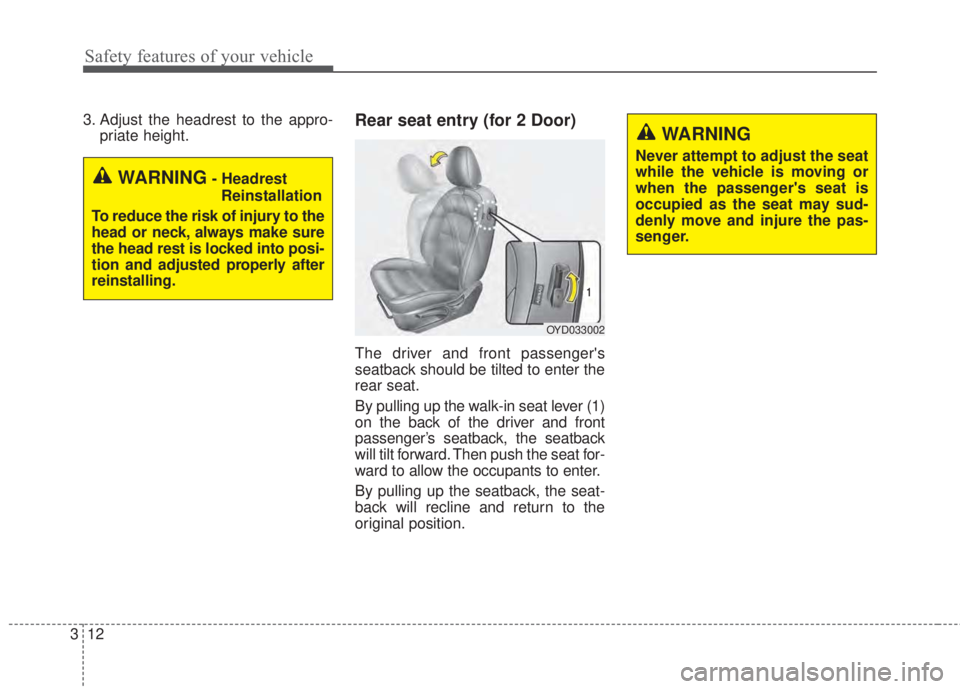
Safety features of your vehicle
12 3
3. Adjust the headrest to the appro-
priate height.Rear seat entry (for 2 Door)
The driver and front passenger's
seatback should be tilted to enter the
rear seat.
By pulling up the walk-in seat lever (1)
on the back of the driver and front
passenger’s seatback, the seatback
will tilt forward. Then push the seat for-
ward to allow the occupants to enter.
By pulling up the seatback, the seat-
back will recline and return to the
original position.
WARNING- Headrest
Reinstallation
To reduce the risk of injury to the
head or neck, always make sure
the head rest is locked into posi-
tion and adjusted properly after
reinstalling.
OYD033002
WARNING
Never attempt to adjust the seat
while the vehicle is moving or
when the passenger's seat is
occupied as the seat may sud-
denly move and injure the pas-
senger.
Page 28 of 595
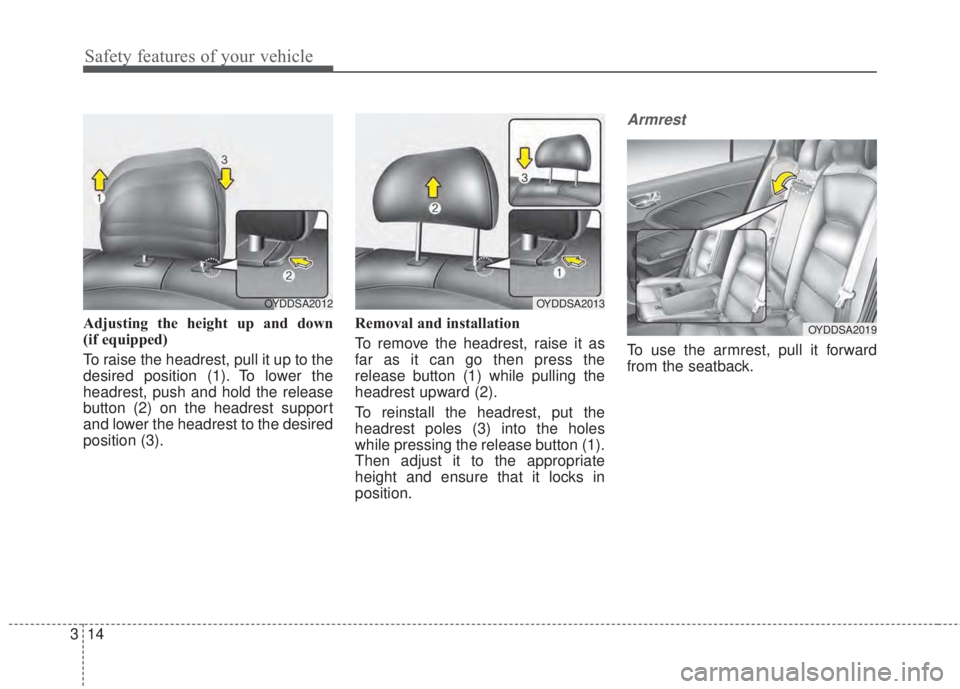
Safety features of your vehicle
14 3
Adjusting the height up and down
(if equipped)
To raise the headrest, pull it up to the
desired position (1). To lower the
headrest, push and hold the release
button (2) on the headrest support
and lower the headrest to the desired
position (3).Removal and installation
To remove the headrest, raise it as
far as it can go then press the
release button (1) while pulling the
headrest upward (2).
To reinstall the headrest, put the
headrest poles (3) into the holes
while pressing the release button (1).
Then adjust it to the appropriate
height and ensure that it locks in
position.
Armrest
To use the armrest, pull it forward
from the seatback.
OYDDSA2013
OYDDSA2019
OYDDSA2012
Page 29 of 595
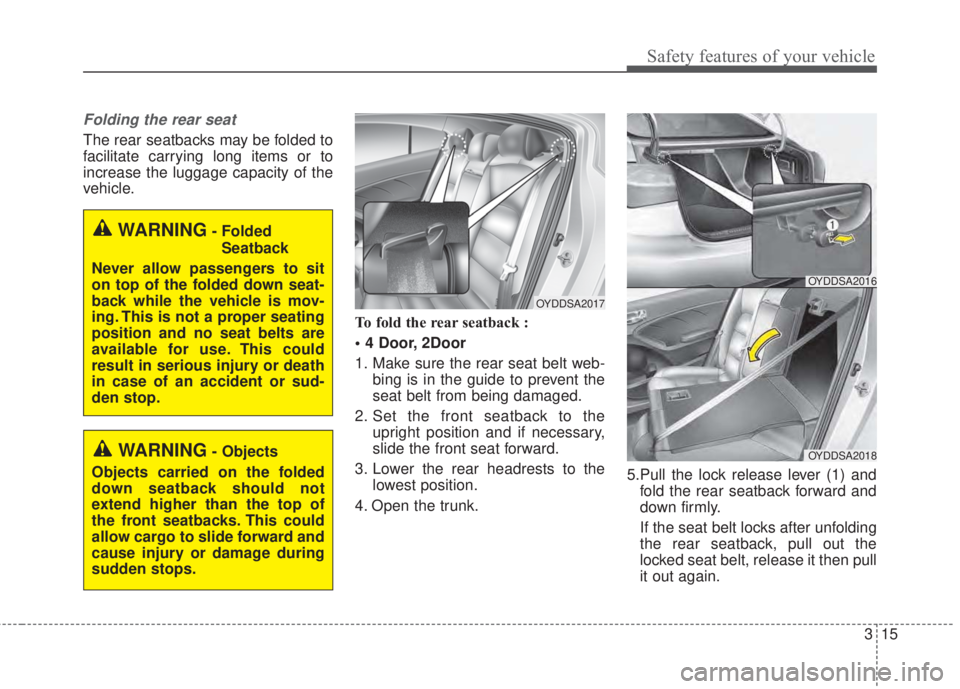
315
Safety features of your vehicle
Folding the rear seat
The rear seatbacks may be folded to
facilitate carrying long items or to
increase the luggage capacity of the
vehicle.
To fold the rear seatback :
• 4 Door, 2Door
1. Make sure the rear seat belt web-
bing is in the guide to prevent the
seat belt from being damaged.
2. Set the front seatback to the
upright position and if necessary,
slide the front seat forward.
3. Lower the rear headrests to the
lowest position.
4. Open the trunk.5.Pull the lock release lever (1) and
fold the rear seatback forward and
down firmly.
If the seat belt locks after unfolding
the rear seatback, pull out the
locked seat belt, release it then pull
it out again.
OYDDSA2017
OYDDSA2018WARNING- Objects
Objects carried on the folded
down seatback should not
extend higher than the top of
the front seatbacks. This could
allow cargo to slide forward and
cause injury or damage during
sudden stops.
OYDDSA2016
WARNING- Folded
Seatback
Never allow passengers to sit
on top of the folded down seat-
back while the vehicle is mov-
ing. This is not a proper seating
position and no seat belts are
available for use. This could
result in serious injury or death
in case of an accident or sud-
den stop.
Page 30 of 595
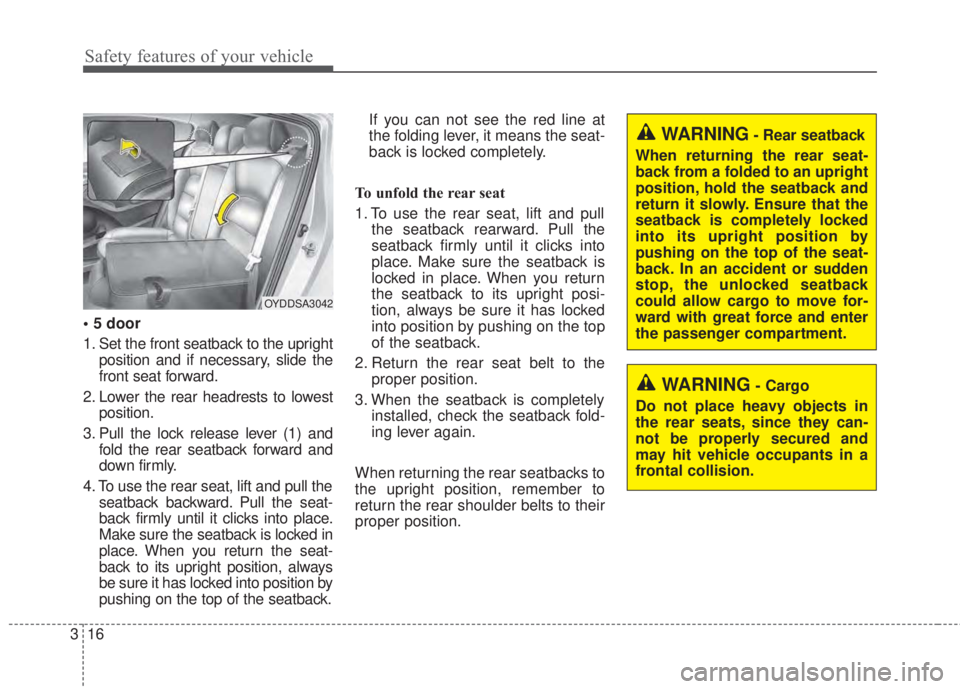
Safety features of your vehicle
16 3
• 5 door
1. Set the front seatback to the upright
position and if necessary, slide the
front seat forward.
2. Lower the rear headrests to lowest
position.
3. Pull the lock release lever (1) and
fold the rear seatback forward and
down firmly.
4. To use the rear seat, lift and pull the
seatback backward. Pull the seat-
back firmly until it clicks into place.
Make sure the seatback is locked in
place. When you return the seat-
back to its upright position, always
be sure it has locked into position by
pushing on the top of the seatback.If you can not see the red line at
the folding lever, it means the seat-
back is locked completely.
To unfold the rear seat
1. To use the rear seat, lift and pull
the seatback rearward. Pull the
seatback firmly until it clicks into
place. Make sure the seatback is
locked in place. When you return
the seatback to its upright posi-
tion, always be sure it has locked
into position by pushing on the top
of the seatback.
2. Return the rear seat belt to the
proper position.
3. When the seatback is completely
installed, check the seatback fold-
ing lever again.
When returning the rear seatbacks to
the upright position, remember to
return the rear shoulder belts to their
proper position.
OYDDSA3042
WARNING- Cargo
Do not place heavy objects in
the rear seats, since they can-
not be properly secured and
may hit vehicle occupants in a
frontal collision.
WARNING- Rear seatback
When returning the rear seat-
back from a folded to an upright
position, hold the seatback and
return it slowly. Ensure that the
seatback is completely locked
into its upright position by
pushing on the top of the seat-
back. In an accident or sudden
stop, the unlocked seatback
could allow cargo to move for-
ward with great force and enter
the passenger compartment.